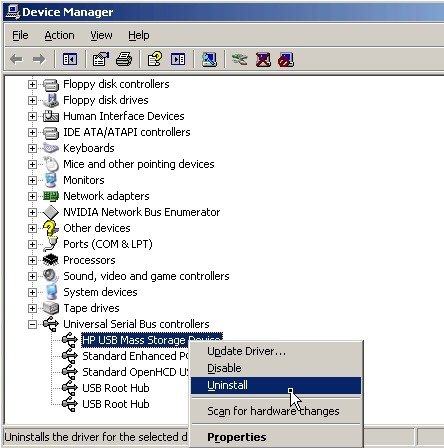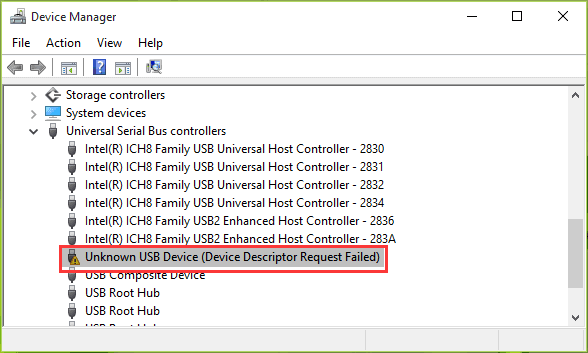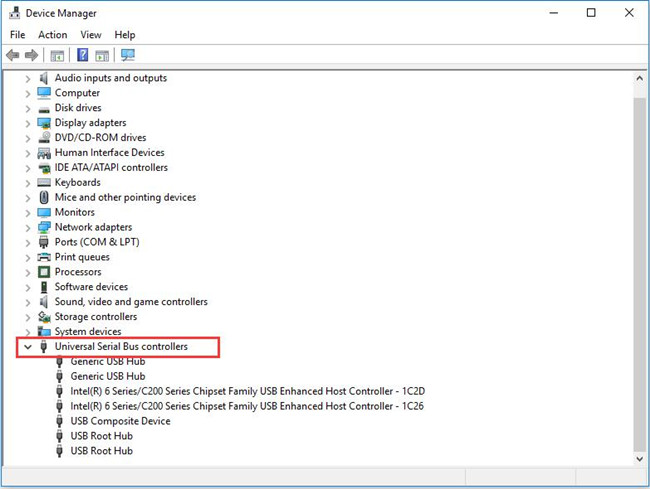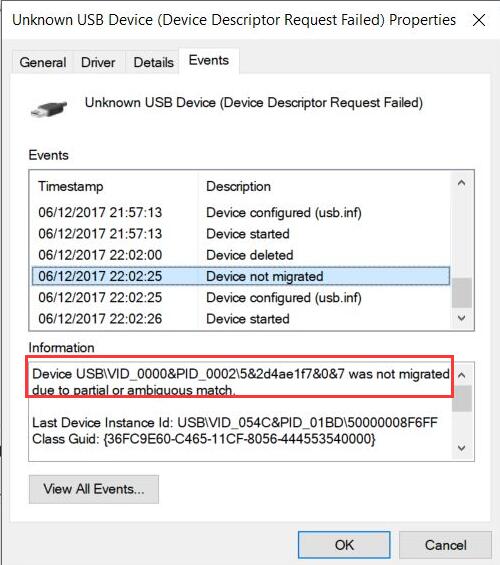Method 2 – Reinstall your external USB driver. If the problem occurs due to corrupted or unstable nature of the external hard drive, then you will need to reinstall and reconnect again. To do that follow these steps: First of all Unplug your USB device from your computer. 1 – Now, Go to: windows 10 search box and search device manager.
Summary :
- To find drivers for unknown devices in Windows, we need to access device manager where you can manage all your hardware device drivers. To open device manager in Windows 8, press “Win + X” to open the power user menu and then select the option “Device Manager.” If you are using Windows 7 or Vista, you can search for the device manager.
- To find drivers for hardware that Windows refuses to recognize, open Device Manager (a search from the Start menu or Windows 8 Start screen brings it up lickity-split), right-click on the listing.
As the abbreviation of Universal Serial Bus, USB is an external bus standard, used for the specification of connection and communication between computer and external device. USB devices can be seen everywhere nowadays: USB flash drive, USB hard drive, USB memory stick, etc. Today, I’ll show you how to do when you find a USB device shows as unknown.

Quick Navigation :
As you can easily find, the USB has become a standard and the most popular PC expansion interface of the twenty-first century. USB devices can be seen in all walks of life; even the game console, SD card, and mouse, keyboard & other hardware components of the computer can be connected through the USB interface.
Error: Unknown USB Device (Device Descriptor Request Failed)
But sometimes, you may run into the Unknown USB Device (Device Descriptor Request Failed) error. How does that happen? Can you fix unknown USB device yourself? How to recover data from the problematic USB drive?
You must care about these things when in face of unknown USB drive problem, right? Taking this into account, I decided to show you how to recover data from unknown USB device and the way to deal with the unknown USB device in Windows 10 properly.
Here is a real case of unknown USB Device (Device Descriptor Request Failed) code 43 in Windows 10:
I have been facing a problem with my USB devices for the past few weeks. Whenever I connect a USB device (mouse, iPhone or even a USB), I get the error Unknown USB Device (Device Descriptor Request Failed) Windows has stopped this device because it has reported problems. (Code 43). As a result, I am unable to connect any USB device to my computer which is very frustrating. In addition to that, I have also discovered that my Bluetooth Devices also shows a similar message Unknown USB Device (Device Descriptor Request Failed) Driver Error. I tried to connect devices (phone, a wireless headset) to my computer but that also failed.– reported by Usman26 on forums.lenovo.com
Recovery: Rescue Data from the Unknown USB Device

Whenever you meet the unknown USB device issue, you are advised to recover data from the unknown USB device at first. When the data recovery has been finished, you can try every possible means to fix the problem (this is for data security reasons).
USB Device Data Recovery Plan
Step one: if you envy the free USB data recovery, please get the following trial edition and install it on your computer properly.
Step two: connect the target USB device to your computer and launch the software you have just installed by double clicking on the icon.
Step three: shift to the Removable Disk Drive option from This PC (checked by default). Then, take a look at the right panel to see whether your USB device appears here.
- If it does appear, please select it and click on the Scan button to start searching for files saved in it.
- If you can’t find your USB device, please try to fix the problem & make it appear here after reading Fix USB Flash Drive Not Recognized & Recover Data – How To Do.
Step four: wait for the scan. Then, browse all the files and folders found & listed by the software to figure out whether they contain the lost data you need.
- If you have found the documents you want, please check them one by one.
- If not all your needed files are here, please wait patiently for the completion of the scan (to get the best recovery result).
Please note that:
- You can choose to Pause the scan when you have to leave for a while and don't want the scan to continue.
- You may as well click on the Stop button to cancel further scans completely when you have found all the files you need in the current scan result.
Step five: click on the Save button located in the lower right corner of the software interface. Then, choose a storage path for the selected files (which are waiting to be recovered from the USB device) and click on the OK button to reconfirm your choice (this step can’t be accomplished if you are using a trial edition to scan the USB drive).
To really recover the needed data from the software scan result, you should:
- Get a license key.
- Register your copy of software with that license.
- Re-scan the USB device and check files to recover.
This is the end of data recovery from an unknown USB device. Actually, the method also works for the situations where you need to recover deleted files from USB drive or fix a broken USB stick.
As for how to recover data from the HDD which shows as unknown, you should read this post carefully:
On discovering your disk shows as unknown, uninitialized or unallocated, you must take actions at once to recover all valuable data from it.
Repair: Fix the Unknown USB Device Issue in Different Ways
As I said earlier, the USB port has been applied to a lot of commonly seen products, mobile phones, USB flash drives, printers, scanners, tablets, laptops, and desktops. You need to connect the USB device to a computer to deal with some data copying, managing and transferring work most of the time.
This is where the problem comes in – an error of Unknown USB Device is given by the Windows computer (and the computers running Linux or other systems). Well, what are you going to do when encountering the following error messages?
- Unknown USB device (device descriptor request failed) nothing plugged in
- Unknown USB device (port reset failed)
- Unknown USB device (the device failed enumeration)
- Unknown USB device (set address failed)
- Error code 43
- …
Please check whether the USB port is damaged or not when you see those error messages: try connecting it through other USB ports on the computer or try to connect it to a different PC. Then, shut down your computer, restart it, and plug the USB device into a good USB port to see whether the problem can be fixed.
If this fails, you should connect the target USB device properly to the computer and then resort to the following workarounds yourself (all steps are finished in a Windows 10 computer).

Workaround 1: Check & Repair Bad Sectors
If bad sectors appear on a USB storage device, the corresponding area can’t be read or written.
How to check and repair:
- Launch MiniTool Partition Wizard to enter its main interface.
- Select the USB disk from the right pane and choose Surface Test from Disk menu (you can also select the USB partition and choose Surface Test from Partition menu when the USB device contains only one partition).
- Click on the Start Now button in the pop-up Surface Test window and wait for the check process.
- Take a glance at the result and decide what to do next (if there are only a few bad sectors, you may try to repair them; if too many bad sectors are found, you’ll need to discard this device and buy a new one, for the sake of data security).
- Repair the bad sectors with special tools when necessary.
Workaround 2: Use Hardware and Device Troubleshooter
Troubleshooter is actually a universal troubleshooting tool built-in in the Windows systems. It works well in checking and repairing many common system problems.
How to use:
- Click on the Start button from the bottom left corner of the screen.
- Scroll down to the S column and select Settings.
- Find Update & Security (Windows Update, recovery, backup) option and click on it.
- Select Troubleshoot from the left pane.
- Select Hardware and Devices under Find and fix other problems area.
- Click on the Run the troubleshooter button appeared.
- Wait for the problems detecting process and follow the on-screen instruction.
- Click on Apply this fix if any problem is found.
This method will help you to solve the unknown USB device problem once it is caused by hardware issues. If the problem persists, please move on to the next solution.
Workaround 3: Uninstall/update the USB Driver
The problematic USB driver (the driver is outdated, corrupted, broken, or missing) is likely to be the cause of the USB device descriptor failure issue.
How to uninstall/update:
- Open Device Manager the way you like (type msc in Run or right click on This PC & choose Manage & select Device Manager).
- Find and expand Universal Serial Bus Controllers from the right pane.
- Now, you can locate the malfunctioned USB drives easily (they are marked with a yellow triangle, with an exclamation point inside).
- Right click on the USB drive and choose Uninstall or Update Driver Software.
- Wait for Windows to execute your operations.
- Restart the computer to see whether the problem has been fixed.
If the problem is still not solved after unknown USB device driver download, please keep reading.
Workaround 4: Change Power Options
You may also change your current power plan to try to fix the unknown device problem.
Here’s how to change:
- Click on the search box on the taskbar (how to fix when taskbar is not working).
- Type settings into the box.
- Select Settings (Trusted Microsoft Store app) from the search result.
- Select System (Display, notifications, power) option from the Settings window.
- Shift to Power & sleep option from Display (which is selected by default).
- Scroll down on the right side of the screen to find Related settings area.
- Click on the Additional power settings option.
- Click on Change plan settings after your current plan.
- Click on Change advanced power settings in the Edit Plan Settings window.
- Find USB settings and expand it.
- Expand USB selective suspend setting.
- Click on the Enabled button after Setting and choose Disabled instead.
- Click on the OK/Apply button.
- Reboot your PC to make the changes take effect.
If the problem is not solved, please turn to the next method.
Workaround 5: Disable Fast Startup
Indeed, the fast startup is a feature embedded with Windows system and related to hibernate and shutdown. It aims at speeding up the computer boost. Yet, some people complained about this: the fast startup generates an ultra-fast execution speed so that the USB device may not be detected by Windows 10 or other systems; thus, the USB device descriptor failure may appear.
Now, I’ll show you how to fix the error by disabling fast startup:
Unknown Usb Device Driver Download Windows 10
- Open the Run dialog box by holding the Windows key and R key on the keyboard at the same time.
- Type control/control panel into the text box after the word Open:.
- Press Enter on the keyboard or click on the OK button in the Run dialog box to open Control Panel.
- Please click on Hardware and Sound option and choose Power Options from the right side when the items are viewed Category (you can choose Power Options directly if all items are viewed by Large icons or Small icons).
- Select Choose what the power button does from the left-hand pane.
- Click on Change settings that are currently unavailable under Define power buttons and turn on password protection.
- Uncheck the Turn on fast startup (recommended) option under Shutdown settings.
- Click on the Save Changes button.
- Restart your computer to see whether the problem has been solved.
You can use the above six ways to solve the unknown USB device problem most of the time.
Final Words
It really doesn’t matter whether you use a USB hard drive or a USB flash drive; in both cases, you’re likely to come across the Unknown USB Device (Device Descriptor Request Failed) error. On this occasion, what really matters is how you respond to the problem.
Unknown Device Driver Download
My advice is recovering data from that unknown USB device first (after all, data is the most important thing). Then, you should follow the methods and steps (I’ve offered in the previous part) to try to repair the error as fast as you can.
Unknown USB Device (Device Descriptor Request Failed) FAQ
- Press Win + R, type devmgmt.msc and click OK.
- Go to find the unknown devices (usually has a special mark).
- Right click on the device and choose Properties.
- Shift to Details tab and find the Property selection.
- Look at the plug-and-play Hardware ID information.
- Locate the device Vendor ID & Product ID from Value list data.
- Poor line or interface contact
- Missing drive letter or drive letter conflict
- Device driver is outdated/damaged/missing
- Power save of USB root hub
- Insufficient/unstable power supply
- Hardware errors on device
- Unsupported file system
Summary :
When you encounter the Unknown USB Device Set Address Failed error, you will be unable to use the USB as normal. To solve this issue, we collect some useful solutions and show them in this post. You can try them to help you out.
SanDisk/Seagate External Hard Drive/WD My Passport Set Address Failed
Sometimes, when you connect an external USB device like a WD my passport, Seagate external hard drive, or SanDisk drive to your computer, you may discover that the drive doesn’t work. Then, you can access Device Manager to check whether there is something wrong with the drive.
There are some common errors like:
- Unknown USB Device (Port Reset Failed)
- Unknown USB Device (Set Address Failed)
- And more…
MiniTool Software hasn’t talked about the Unknown USB Device Set Address Failed issue. In this post, we will show you some solutions.
These solutions are available for WD my passport set address failed, Seagate external hard drive set address failed, and SanDisk set address failed. Of course, if you are using other brands of USB devices, they can also work.
If you are sure the exact reason for this issue, you can try these solutions one by one until you find the most suitable one for your case.
How to solve unknown USB device set address failed?
- Modify Power Options
- Update or roll back the device driver
- Use Hardware and Devices Troubleshooter
- Turn off Fast Startup
Solution 1: Modify Power Options
If you are using a laptop, you need to check whether the setting in Power Option is set correctly. You can follow these steps to modify Power Options:
1. Press Win+R to open Run.
2. Type cpl and press Enter to directly open Power Options.
3. Click the Change plan settings link that is next to the preferred plan the system selects.
4. Click the Change advanced power settings link to continue.
5. Scroll down to the USB settings section and then set Disable for both the scenarios: On Battery and Plugged in.
6. Click OK to keep the change.
Solution 2: Update or Roll Back the USB Device Driver
If the USB device driver is not up-to-date, the Unknown USB Device Set Address Failed error can appear. On the other hand, this issue can also happen after you update the device driver. You need to verify which situation you are facing and then choose to update or roll back the USB device driver.
If you need to update the device driver, you can refer to this post: How to Update Device Drivers Windows 10 (2 Ways).
If you need to roll back the device driver, you can refer to this post: How to Roll Back a Driver in Windows? A Step-by-Step Guide.
Solution 3: Use Hardware and Devices Troubleshooter
You can also use the Hardware and Devices Troubleshooter to get rid of the Unknown USB Device Set Address Failed issue. You just need to go to Start > Settings > Update & Security > Troubleshoot > Hardware and Devices, and then follow the on-screen guide to do the job.
Solution 4: Turn off Fast Startup

1. Press Win+R to open Run.
2. Type cpl and press Enter to directly open Power Options.
3. Click Choose what the power button does.
4. Click Change settings that are currently unavailable.
5. Uncheck the Turn on fast start-up (recommended).
Those are the solutions to Unknown USB Device Set Address Failed. We hope they can help you out. Should you have any related issues, you can let us know in the comment.